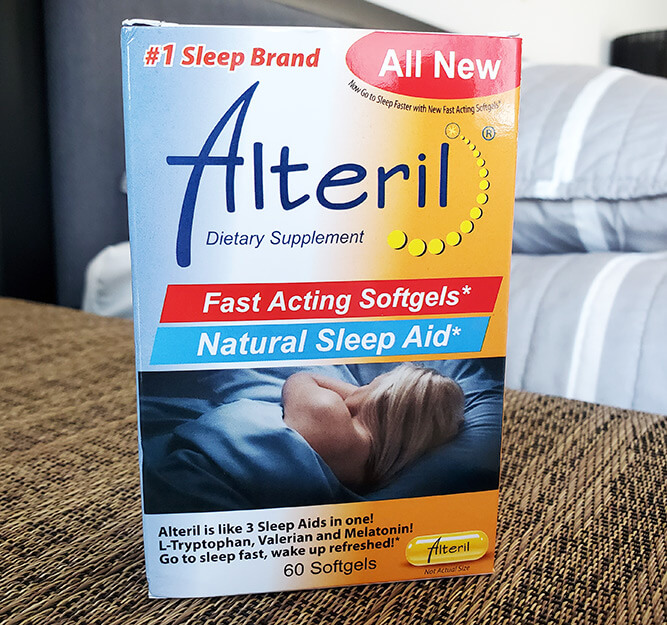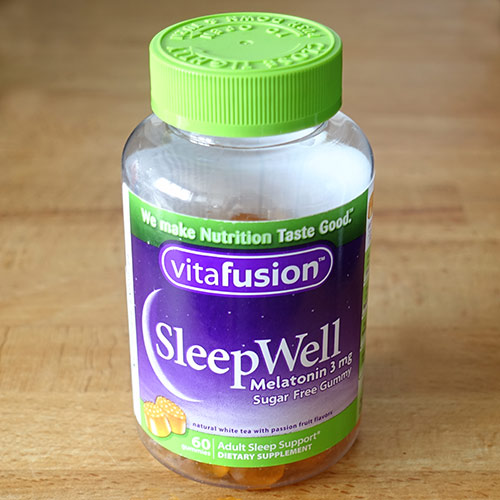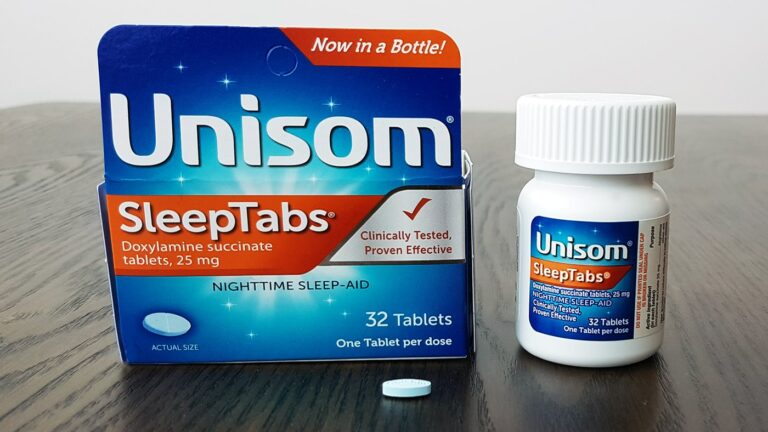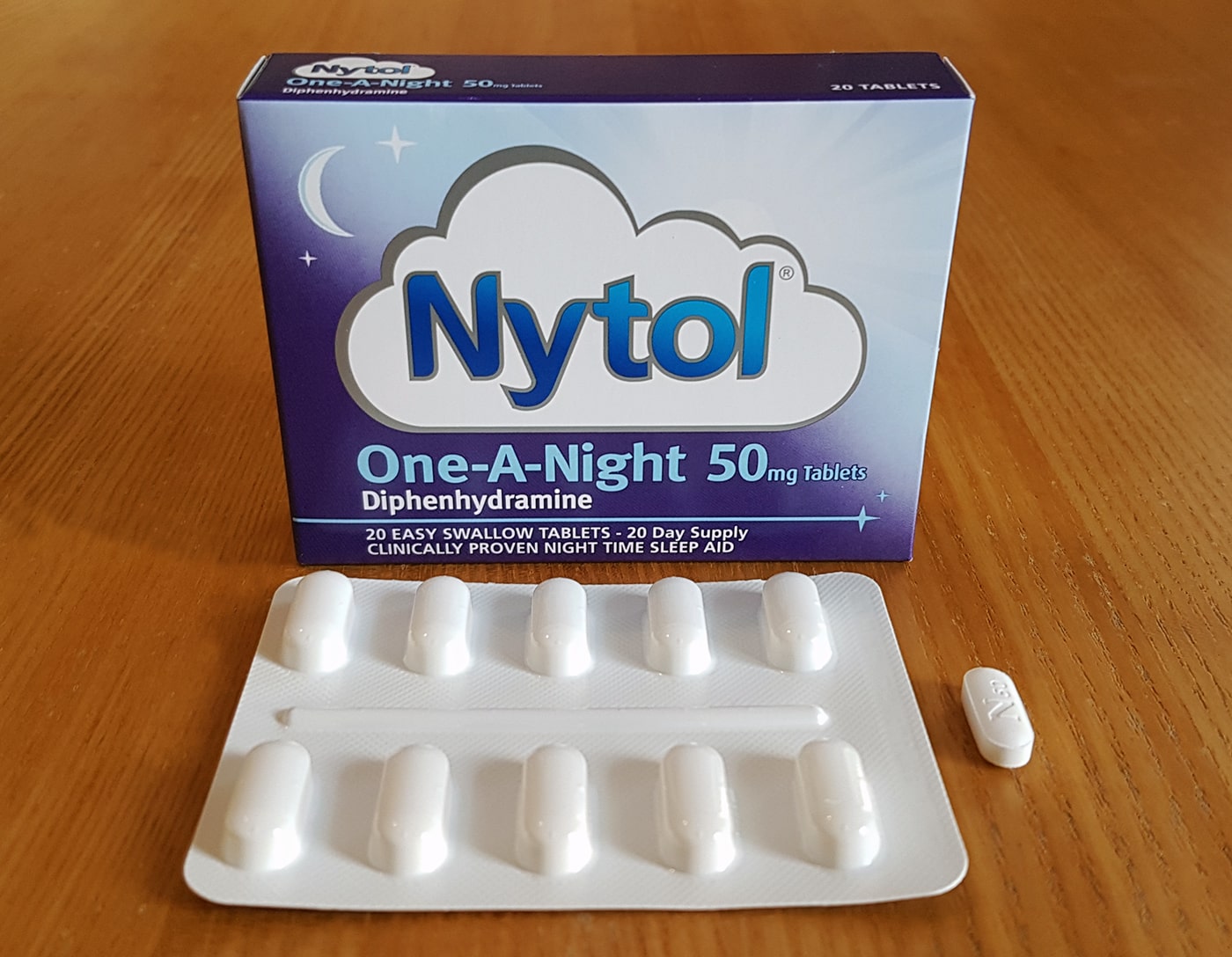
Disclosure: This review is based on my personal experience of Nytol One-A-Night, and you may have a different experience. Please discuss taking any new sleep aid with a healthcare professional rather than only relying on online sources.
Updates: I first wrote this article in 2013 when I took the Nytol. The most recent update in 2024 was to remove the warnings and side effects listed on the leaflet when I bought it as this information may have changed over time.
I recently tried Nytol One-A-Night, which is an over the counter sleeping pill containing the antihistamine diphenhydramine as the active ingredient.
I also tried the Nytol Herbal version not long ago, so I’ll be comparing the effectiveness of both in this review.
I took the herbal version for three nights, and then had a week without using any sleep aids. Following that, I took one 50 mg tablet of the One-A-Night for four nights.
I know from experience that antihistamine sleeping pills work quite well for me, so there was more of a chance of a placebo effect. I’ll try to give as unbiased an account as possible though.
My experience
The Nytol knockout
Compared to the herbal version, I thought I might experience a more noticeable sedative effect. That’s kind of what happened, just not exactly how I imagined.
The instructions say to take it 20 minutes before bed. I did that on the first night and stayed awake reading for around 40 minutes – I was curious to see if I could detect any feeling of drowsiness that was different from how I’d normally feel in bed.
There was still no noticeable effect after 40 minutes, so I switched the light off anyway. I believe I then fell asleep within ten minutes, and woke up nine hours later!
I didn’t wake up once during the night, which is unusual for me, and overslept the alarm by one hour. So it appeared that the Nytol had done its job.
Feeling the effects in the morning
In the morning, I felt quite refreshed – both mentally and physically. However, I also had a bit of a fuzzy head and felt some light pressure on my forehead, just above my eyes.
It’s strange when sleep aids work this way; I feel like I slept well, but also have some nagging side effects that remind me that I took a sleep aid the night before.
The fuzzy sensations slowly faded on their own, taking a couple of hours to completely disappear. So although the Nytol seemed to give me a good night’s sleep, it didn’t leave me feeling 100% the next morning. I was still able to go about my day and work, but those symptoms were annoying.
The following nights
On the second night, I repeated the same routine. There was the same effect of not feeling drowsy, but I still fell asleep relatively quickly. I again woke up in the morning without any memory of nocturnal wakings. And once again, I had a fuzzy head.
On the third night, I don’t think the sedative effect was quite as strong. The manufacturer advises that you can develop a tolerance to Nytol, but night three seemed quite soon to me.
I woke up a couple of times in the night this time, but admittedly still slept pretty well. The next morning symptoms were similar though.
I tried it one more time, and again didn’t have a repeat of the first or second night’s total knockout, but still slept quite well.
By this point, I’d had enough of the groggy feeling, was content with a couple of good nights’ sleep, and didn’t take them again that week.
How it compares with the herbal type
The first thing to note is that the Nytol One-A-Night didn’t smell or taste as bad as the valerian-based herbal ones, so that’s a plus.
For me personally, they appeared to be considerably stronger in effect than the herbal pills. Strangely, I did feel a sedative effect with the others while still awake, which I didn’t with the One-A-Night.
I didn’t feel any effects the next day with the herbal pills though, so they both have their pros and cons.
Please remember that this was just my experience with the two types. It could be completely different for you.
Update: trying Nytol Original (25mg)
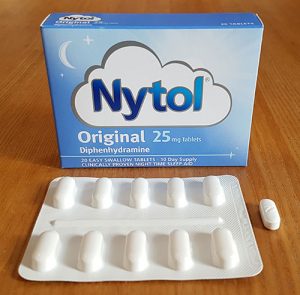
The Nytol Original I bought seemed very similar to the One-A-Night, except having to take 2 x 25 mg pills instead of 1 x 50 mg.
I was curious to see what would happen if I only took 25 mg, and if the lingering next-day effects would be less of an issue.
I tried just one pill for three consecutive nights and did find they were better for me. I still experienced a sedative effect – not as much as the 50 mg dosage, but enough to help me sleep a bit better.
The headache and fuzzy head weren’t as bad in the morning, but I still didn’t feel 100% clear-headed. Still, I liked having the option to take a smaller amount so I could see if the side effects were better.
Trying other sleep aids that contain diphenhydramine
Nytol isn’t the only sleep aid that uses diphenhydramine as the active ingredient. I’ve now tried a couple of others and had a similar experience each time. They do seem to do something for my sleep, but at the cost of feeling some side effects in the morning.
Further information
Nytol ingredients
From the instruction leaflet on the pack I bought, the ingredients were:
- Diphenhydramine hydrochloride 50mg
- Anhydrous lactose
- Microcrystalline cellulose
- Maize starch
- Stearic acid
- Silicon dioxide
Side effects and warnings
I have removed the list of side effects and warnings that were on the leaflet I bought back in 2013 because they may not be the same all these years later.
What I will say is that there was quite an extensive list of possible side effects that people might experience.
There was also an extensive list of warnings of which groups of people should not take this version of Nytol.
So it’s wise to consult a healthcare practitioner before you take it to check that it’s safe and appropriate for you personally.
Warnings for older adults
One warning that was not on the patient leaflet when I bought mine was for older adults. If you’re an adult aged 65 or over, I recommend consulting your primary care doctor, physician, or pharmacist before taking Nytol. The same applies for any sleep containing the antihistamines diphenhydramine or doxylamine.
As the Mayo Clinic states:
Be aware, too, that first-generation antihistamines typically are not recommended for adults 65 and older. That’s because they have something called anticholinergic properties. Research suggests those properties might raise the risk of dementia. In older adults, these medicines also may raise the risk for the following side effects:
- Confusion.
- Dry mouth.
- Constipation.
- Problems emptying the bladder completely, a condition called urinary retention.
- Blurred vision.
If you’d like to find out more about this issue, here are some more sources to read:
Researchers at the University of Pittsburgh published an interesting study in 2018. Here’s a quote from their work that summarises the issue clearly:
Diphenhydramine has potentially harmful effects on older adults including risk of motor impairment and anticholinergic effects; its use is also associated with falls. Diphenhydramine may be especially dangerous in older adults due to its longer half-life compared younger individuals. Another safety risk of using diphenhydramine at night is the presence of a residual sedative effect the morning after use .
Choosingwiselycanada.org also briefly mentions that the antihistamines should be avoided.
Interestingly, in the UK, the website of the National Health Service only recommends starting with the lower dose if you’re aged over 65 because you’re more likely to get side effects. I think it’s wise to ask your GP for their advice first though if you plan on using it as a sleep aid.
Further reading
As well as discussing using it with your own doctor, you can use the Nytol website contact page to ask the manufacturer questions (not a paid link).
You might also find it useful to read my sleep hygiene tips.


